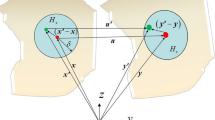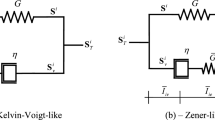Abstract
A R-minimum strategy, which was proposed and successfully applied to analyse the non-linear rate-independent finite deformation (including the thermal–mechanical coupling and frictional contact) of elasto-plastic materials, is extended and applied here to simulate the deformation of rate-dependent materials. It involves no iterations, thus belongs to the static-explicit algorithm and avoids the convergence problem resulting from nonlinearities. The R-minimum strategy-based adaptive control scheme of the time step size is proposed and applied to the related analysis of the rate-dependent materials with both the time-dependent and the time-independent viscosity. Both the simple benchmark test and the practical application in evaluation of the effect of the Earth materials on its response to the centrifugal force are carried out to demonstrate the stability, efficiency and usefulness of this algorithm.











Similar content being viewed by others
References
Gong XN (1995) Constitutive equations of engineering materials. Architecture and Building Press, Beijing
Hughes TJR (1980) Generalization of selective integration procedures to anisotropic and nonlinear materials. Int J Numer Methods Eng 15:1413–1418. doi:10.1002/nme.1620150914
Kawka M, Makinouchi A (1995) Shell element formulation in the static explicit FEM code for simulation of sheet stamping. J Mater Process Technol 50:105–115. doi:10.1016/0924-0136(94)01373-9
Laursen TA, Simo JC (1993) A continuum-based finite element formulation for implicit solution of multi-body, large deformation frictional contact problems. Int J Numer Methods Eng 36:3451–3485. doi:10.1002/nme.1620362005
McMeeking RM, Rice JR (1975) Finite element formulation for problems of large elastic–plastic deformation. Int J Solids Struct 11:601–616. doi:10.1016/0020-7683(75)90033-5
Santos A, Makinouchi A (1995) Contact strategies to deal with different tool descriptions in static explicit FEM of 3-D sheet metal forming simulation. J Mater Proc Technol 50:277–291. doi:10.1016/0924-0136(94)01391-D
Sheet Forming Simulation Research Group (1996) ITAS3D user’s manual, Version 2, Sheet Forming Simulation Research Group, Japan
Simo JC, Taylor RL (1985) Consistent tangent operators for rate-independent elasto-plasticity. Comput Methods Appl Mech Eng 48:101–118. doi:10.1016/0045-7825(85)90070-2
Sloan SW (1987) Substepping schemes for the numerical integration of elastoplastic stress–strain relations. Int J Numer Methods Eng 24:893–911. doi:10.1002/nme.1620240505
Xing HL, Mora P, Makinouchi A (2006) An unified friction description and its application to simulation of frictional instability using finite element method. Philos Mag 86:3453–3475. doi:10.1080/14786430500198452
Xing HL, Fujimoto T, Makinouchi A (1999) FE modelling of multiple thermo-elasto-plastic body contact in finite deformation and its application to tube and tubesheet assembling. Effective Engineering Analysis, NAFEMS, UK, pp 669–680
Xing HL, Makinouchi A (2000) A node-to-point contact element strategy and its applications. RIKEN Rev Focused High Perform Comput 30:35–39
Xing HL, Makinouchi A (2001) Numerical analysis and design for tubular hydroforming. Int J Mech Sci 43:1009–1026. doi:10.1016/S0020-7403(00)00046-1
Xing HL, Makinouchi A (2002) FE modelling of thermo-elasto-plastic finite deformation and its application in sheet warm forming. Eng Comput Int J Comput Aided Eng Softw 19:392–410. doi:10.1108/02644400210430172
Xing HL, Makinouchi A (2002) Finite element analysis of sandwich friction experimental model of rocks. Pure Appl Geophys 159:1985–2009. doi:10.1007/s00024-002-8719-6
Xing HL, Makinouchi A (2002) Finite-element modelling of multibody contact and its application to active faults. Concurr Comput Pract Experience 14:431–450. doi:10.1002/cpe.623
Xing HL, Makinouchi A (2002) Three dimensional finite element modelling of thermomechanical frictional contact between finite deformation bodies using R-minimum strategy. Comput Methods Appl Mech Eng 191:4193–4214. doi:10.1016/S0045-7825(02)00372-9
Xing HL, Makinouchi A (2003) Finite element modelling of frictional instability between deformable rocks. Int J Numer Anal Methods Geomech 27:1005–1025. doi:10.1002/nag.309
Xing HL, Mora P, Makinouchi A (2003) Finite element simulation of stress evolution in a frictional contact system, vol 4. Lecture Notes in Computer Science. Springer, Berlin, pp 798–806
Xing HL, Mora P, Makinouchi A (2004) Finite element analysis of fault bend influence on stick-slip instability along an intra-plate fault. Pure Appl Geophys 161:2091–2102. doi:10.1007/s00024-004-2550-1
Xing HL, Wang ZR (1997) Finite element analysis and design of thin sheet superplastic forming. J Mater Process Technol 68:1–7. doi:10.1016/S0924-0136(96)02510-1
Xing HL, Wang ZR (1998) Prediction and control of cavity growth during superplastic sheet forming with finite element modelling. J Mater Process Technol 75:87–93. doi:10.1016/S0924-0136(97)00296-3
Xing HL, Zhang KF, Wang ZR (1994) Study on the optimal mode of superplastic deformation. J Mater Process Technol 44:29–34. doi:10.1016/0924-0136(94)90035-3
Xing HL, Zhang KF, Wang ZR (2004) Recent development of mechanics of superplasticity and its applications. J Mater Process Technol 151:196–202. doi:10.1016/j.jmatprotec.2004.04.039
Xing HL, Zhang J, Yin C (2007) A finite element analysis of tidal deformation of the entire earth with a discontinuous outer layer. Geophys J Int 170:961–970. doi:10.1111/j.1365-246X.2007.03442.x
Yamada Y, Yoshimura N, Sakurai T (1991) Plastic stress-strain matrix and its application for the solution of elastic -plastic problems by finite element method. Int J Mech Sci 10:343–354. doi:10.1016/0020-7403(68)90001-5
Acknowledgments
Support is gratefully acknowledged by the relevant national projects of ARC DP066620, LP0560932 and NSFC 40728004. The authors are grateful to the three anonymous reviewers for their advice/comments that allowed this paper to be improved.
Author information
Authors and Affiliations
Corresponding author
Rights and permissions
About this article
Cite this article
Xing, H.L., Zhang, J. Finite element modelling of non-linear deformation of rate-dependent materials using a R-minimum strategy. Acta Geotech. 4, 139–148 (2009). https://doi.org/10.1007/s11440-009-0090-7
Received:
Accepted:
Published:
Issue Date:
DOI: https://doi.org/10.1007/s11440-009-0090-7




